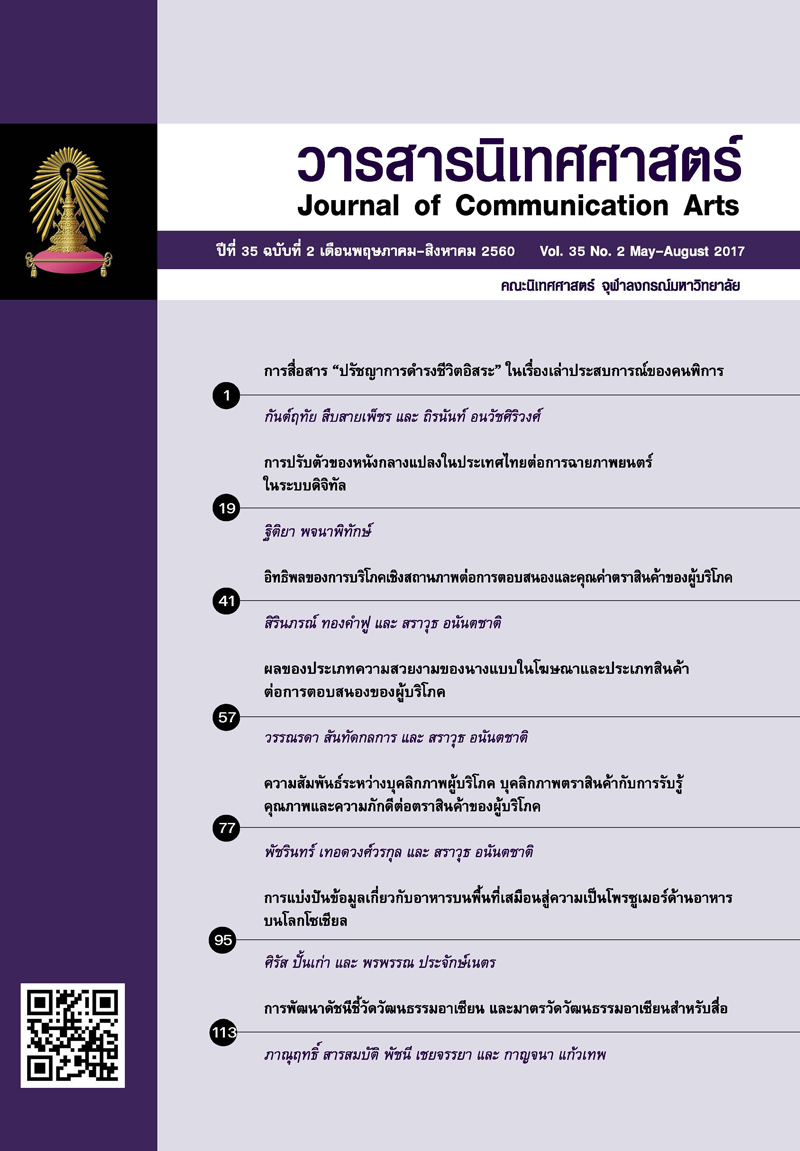การสื่อสาร “ปรัชญาการดำรงชีวิตอิสระ” ในเรื่องเล่าประสบการณ์ของคนพิการ
Main Article Content
Abstract
This research aimed to study attributes, narrative paradigm and communication tactics of “Independent Living Philosophy” through personal experience narratives of persons with disabilities including attitudes of persons relating to publication. The rhetorical framework is Narrative Paradigm by Walter R. Fisher. The research methodology include textual analysis, documentary research, and semi-structured interview.
The study found that attributes of personal experience narratives of persons with disabilities - authors with physical or motion disabilities are of highest number and all disabilities are obtained later. The objective of writing focuses on the story of struggling in life and on the creation of good understanding towards the disabled. Narrative paradigm from the elements of the stories communicate ‘Independent Living Philosophy’. Particularly, the main characters uphold value of freedom, self-pride, and being religious. On communication tactics, ‘Independent Living Philosophy’ relies on the narrative probability and fidelity. The narrative fidelity rests on explicit values that will lead to the ideal basis for human conduct which is the devotion to others and equitable society. Attitudes of the persons relating to publication are interviewed and found that they wish to give moral support to readers to struggle in life. The most expected value of these narratives is positive attitude. The consequence on readers at personal is developing a positive mindset and at societal level: better understanding and equality for all.
Article Details
References
พงษ์เทพ สันติกุล. (2552). คนพิการในงานวิจัย: เข้าใจคนพิการผ่านตัวหนังสือ. กรุงเทพฯ : พริกหวาน กราฟฟิก จำกัด.
พิมพาภรณ์ นวลมี. (2547). รูปแบบหลักในการสื่อสารของครูกับเด็กปัญญาอ่อนระดับตติยภูมิ. วิทยานิพนธ์ปริญญามหาบัณฑิต, ภาควิชาวาทวิทยาและสื่อสารการแสดง คณะนิเทศศาสตร์ จุฬาลงกรณ์มหาวิทยาลัย.
วราวรรณ คงคล้าย. (2539). ปัญหาในการสื่อสารของคนหูหนวกในชีวิตประจำวันที่เกี่ยวข้องกับการค้าขาย. วิทยานิพนธ์ปริญญามหาบัณฑิต, ภาควิชาวาทวิทยาและสื่อสารการแสดง คณะนิเทศศาสตร์ จุฬาลงกรณ์มหาวิทยาลัย.
สถาบันวิจัยระบบสาธารณสุข. (2553). การจัดการความรู้และสังเคราะห์แนวทางปฏิบัติของโรงพยาบาล ส่งเสริมสุขภาพตำบล: ประสบการณ์การทำงานสร้างเสริมสุขภาพคนพิการ. กรุงเทพฯ :
สหมิตรพริ้นติ้งแอนด์พับลิสชิ่ง จำกัด.
สำนักงานส่งเสริมและพัฒนาคุณภาพชีวิตคนพิการแห่งชาติ. (2553). คู่มือการตรวจประเมินและวินิจฉัยความพิการ ตามพระราชบัญญัติส่งเสริมและพัฒนาคุณภาพชีวิตคนพิการ พ.ศ. ๒๕๕๐. กรุงเทพฯ : ชุมนุมสหกรณ์การเกษตรแห่งประเทศไทย จำกัด.
สำนักนโยบายและยุทธศาสตร์ กระทรวงสาธารณสุข. (2554). บทบาทภาครัฐเพื่อการส่งเสริมและพัฒนา คุณภาพชีวิตคนพิการ. กรุงเทพฯ : สามเจริญพาณิชย์.
อรวรรณ ปิลันธน์โอวาท. (2550). หลักและปรัชญาวาทวิทยา. พิมพ์ครั้งที่ 2. กรุงเทพฯ : สำนักพิมพ์แห่ง จุฬาลงกรณ์มหาวิทยาลัย.
อัฐมา โภคาพานิชวงษ์. (2549). ภาพสะท้อนและเรื่องเล่า “ความพิการ” ของผู้พิการในสังคมไทย. [ม.ป.ท.].
ภาษาอังกฤษ
Fisher, W. R. (1987). Human Communication as Narration: Philosophy of Reason, Value and Action. Columbia: University of South Carolina Press.
Herman, D. (2005). Routledge Encyclopedia of Narrative Theory. NY: Taylor & Francis Group.
Ratzka, Adolf (2005). What is Independent Living. Retrieved from http://www.independentliving
.org/toolsforpower/tools11.html
Stiker, H. J. (1999). A History of Disability. Ann Arbor: University of Michigan Press.


